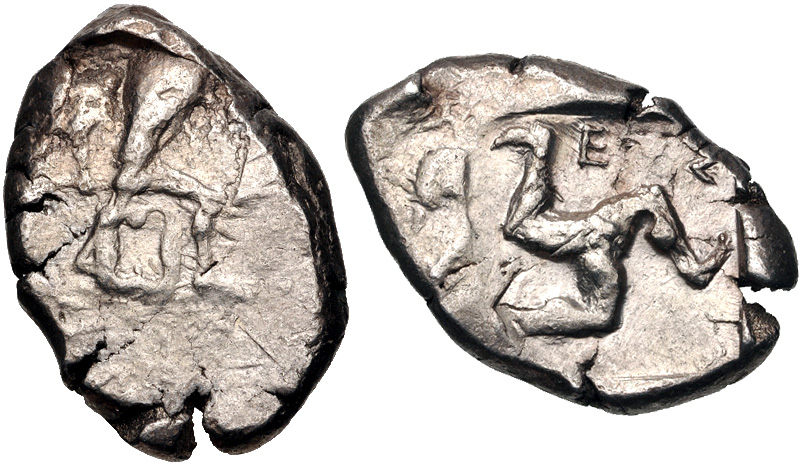2526 - Aspendus (double siglos hoplite/triskeles) over uncertain type (CNG, EA 437, Febr. 2019, 142): Difference between revisions
From SILVER
No edit summary |
No edit summary |
||
| Line 10: | Line 10: | ||
|Ancient region=Pamphylia | |Ancient region=Pamphylia | ||
|Authority=Persian Empire | |Authority=Persian Empire | ||
|Date from= | |Date from=464 BCE | ||
|Date to=430 BCE | |Date to=430 BCE | ||
|Period=Classical | |Period=Classical | ||
Revision as of 10:06, 30 July 2023
464 BCE - 430 BCE | ΕΣ
Images
Overstriking coin

SO_1744_-_Aspendus_(didrachm_hoplite-triskeles).jpeg [1]
Location/history
| Sale(s)Sale(s) ᵖ: | Classical Numismatic Group, EA 437, 6 Febr. 2019, 142 | |
Overstriking coin
Description
| ObverseInscription or printing placed on the obverse.: | Warrior walking right, naked, wearing helmet, holding spear in right hand, shield attached on left arm. | ReverseInscription or printing placed on the reverse.: | ΕΣ (Greek) Triskeles of human legs within incuse square. |
Mint and issuing power
| MintIdentifies the place of manufacture or issue of a numismatic object.: | Aspendus | Ancient regionAncient region. | Pamphylia | Modern countryModern country: Turkey | AuthorityIdentifies the issuing power. The authority can be "pretended" when the name or the portrait of X is on the coin but he/she was not the issuing power. It can also be "uncertain" when there is no mention of X on the coin but he/she was the issuing power according to the historical sources: | Persian Empire |
Chronology
| FromIdentifies the initial date in a range assigned in a numismatic context. 464 BCE toIdentifies the final date in a range assigned in a numismatic context.. 430 BCE | Classical 480-323 BC |
Physical description
| MetalThe physical material (usually metal) from which an object is made.: Silver |
WeightWeight of the numismatic object (in grams). in grams: 10.5710.57 g <br />10,570 mg <br /> | DenominationTerm indicating the value of a numismatic object. Examples: tetradrachm, chalkous, denarius.: double siglos |
AxisDescribes the directional relationship between the obverse and reverse of a numismatic object.: 33 mm <br />0.3 cm <br /> |
| DiameterDescribes diameter of an object (in mm).: 1717 mm <br />1.7 cm <br /> | StandardStandard.: Persian | ||
References
| Coin referenceReference of the Coin: | Coin series referenceReference to coin series study: | Babelon 19011Babelon 1901, Part 2, Tome 1, p. 526-530, n° 855-867, SNG Copenhagen Lycia-Pamphylia2SNG Copenhagen Lycia-Pamphylia, n° 153-179, SNG von Aulock Pamphylien3SNG von Aulock Pamphylien, n° 4477-81, SNG France 34SNG France 3, n° 1-11 | |
| Coin series web referenceCoin series web references: | |||
Overstruck type
Description
| ObverseInscription or printing placed on the obverse.: | ReverseInscription or printing placed on the reverse.: |
Mint and issuing power
| MintIdentifies the place of manufacture or issue of a numismatic object. ᵖ: | Ancient regionAncient region. ᵖ | Modern countryModern country: | AuthorityIdentifies the authority in whose name (explicitly or implicitly) a numismatic object was issued. ᵖ: |
Chronology
| FromIdentifies the initial date in a range assigned in a numismatic context. toIdentifies the final date in a range assigned in a numismatic context.. | periodTime period of the numismatic object. |
Physical description
References
| Coin type referenceReference to coin series study ᵖ: |
Additional data
| Frequency of overstrikesFrequency of overstrikes: | frequent | Level of confidenceLevel of confidence of the identification: | |
| RemarksRemarks: | "Overstruck. Undertype visible" | ||
References
- ^ Babelon, Ernest (1901), Traité des monnaies grecques et romaines. Tome Premier. Première partie, théorie et doctrine, Paris, E. Leroux
- ^ Breitenstein, Niels (1955), Sylloge Nummorum Graecorum: Royal Collections of coins and medals. Danish National Museum, 31, Lycia-Pamphylia.
- ^ Sylloge Nummorum Graecorum. Sammlung v. Aulock. Pamphylien. 11 Heft (n° 4477-4893), Berlin, 1965.
- ^ Levante, Edoardo [with the collaboration of Peter Weiss] (2001), Sylloge nummorum graecorum. France. 3, Département des monnaies, médailles et antiques : Pamphylie, Pisidie, Lyaconie, Galatie, Paris-Zürich, Bibliothèque nationale de France-Numismatica Ars Classica, XXXIV + 293 p. and 146 pl.